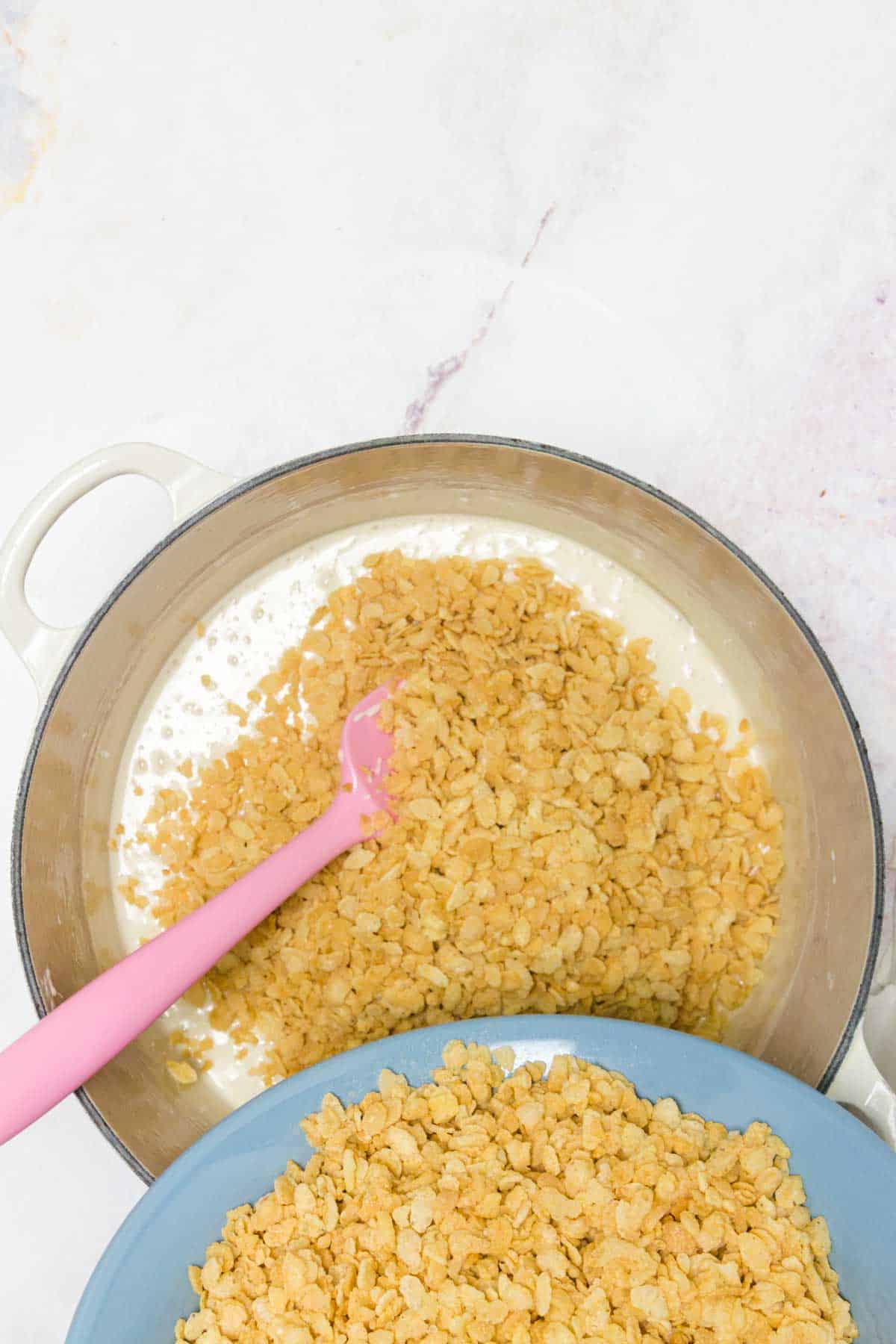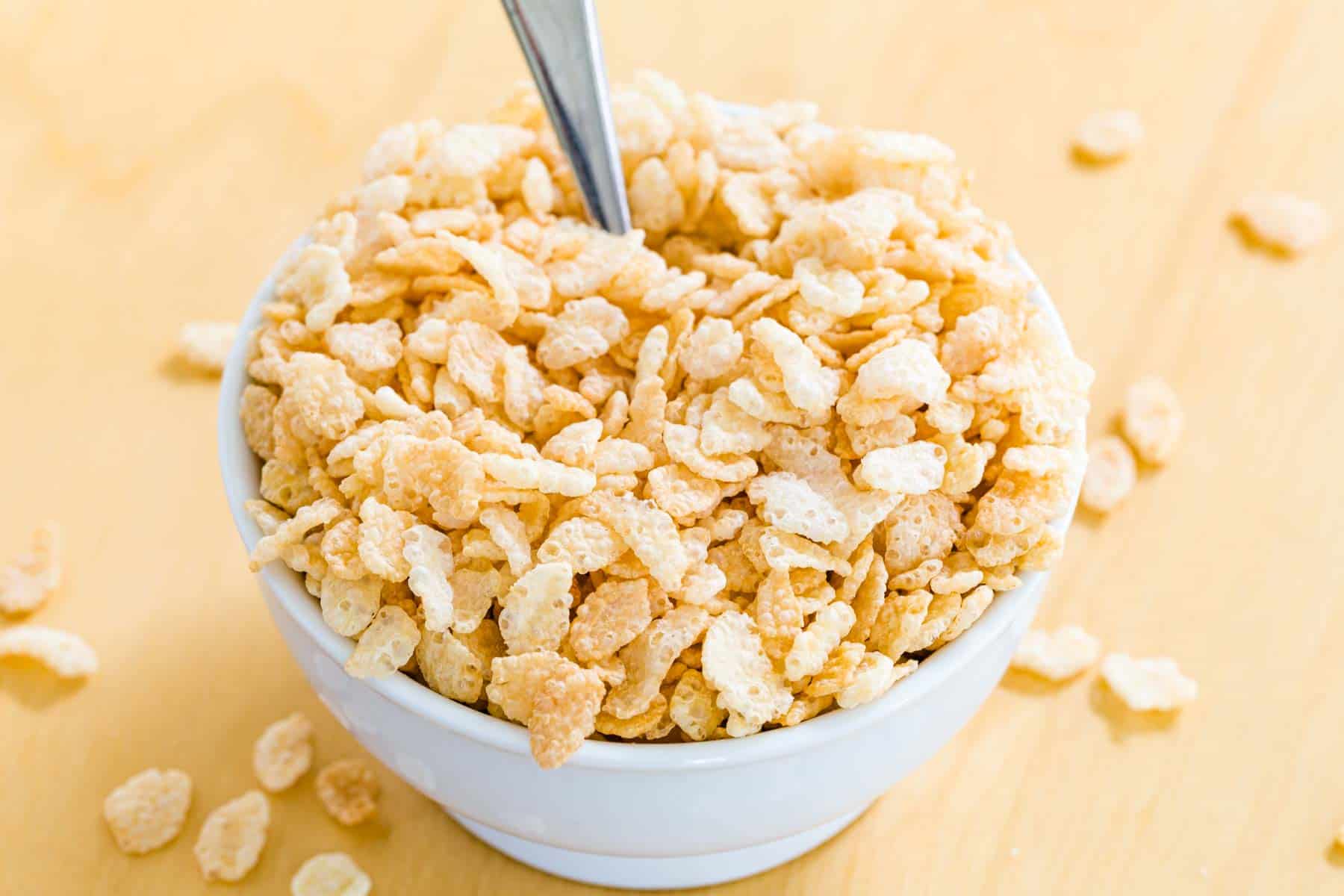


Are Rice Krispies Gluten Free? No, the ones from Kellogg’s are not, but there are alternatives. Let’s dive into everything you want to know about crispy rice cereal and gluten sensitivity. Plus, check out the gluten-free crispy rice cereal brands below that ARE safe to eat!

Yes, you read correctly. Who else is as shocked as I was to learn that Rice Krispies cereal is NOT gluten-free? I know what you might be thinking (because I thought the same): isn’t Rice Krispies just, well, rice? As it turns out, not so much.
To thicken the plot, Rice Krispies used to be gluten-free. However, Kellogg’s discontinued its gluten-free version in 2015, citing manufacturing difficulties. Currently, Rice Krispies are made with malt syrup, which is derived from barley. And just like that, the cereal is no longer safe for gluten-free diets or those with celiac disease.
But, never fear. There are alternatives! Below, we dive into everything you need to know about crispy rice, including ingredients to look out for, cross-contamination, and more. Plus, I’ve included gluten-free brands to use in Gluten-Free Rice Krispies Treats, Peanut Butter Rice Krispie Treats, no-bake desserts, and more delicious gluten-free baking.
Related: Are Marshmallows Gluten Free?

Rice Krispies cereal is made from a paste of rice and sugar, that’s shaped into “rice” and then toasted to become small, crispy puffs. When the thin outer shell comes into contact with milk, it collapses, which creates the cereal’s signature “snap, crackle, pop” sound.
When it comes to buying gluten-free crispy rice brands, always, always check those labels! This is one of my biggest mottos for gluten-free shopping. As is the case with Rice Krispies, gluten can lurk in foods that might otherwise seem totally safe to eat.
It’s important to read ingredient lists carefully. There are certain “red flag” ingredients to look out for that can indicate a product contains gluten. These include any references to malt (ie. malt extract, malt syrup, and malt flavoring), wheat (wheat starch), rye, barley, brewer’s yeast, durum, semolina, bulgur, etc.
Also, watch out for any statement along the lines of “may contain…”. Sometimes, even though a product is made without any gluten, it may be manufactured alongside gluten-containing products (see cross-contamination risks below).

So, with Kellogg’s Rice Krispies out of the equation, which crispy rice brands are safe to turn to? Below are some alternatives to Rice Krispies that are considered safe for gluten sensitivities:
According to the company website, Nature’s Path organic crispy rice is naturally gluten-free. Their packaging also carries the Certified Gluten-Free seal from the GFCO (Gluten-Free Certification Organization). This makes their crispy rice cereal a great choice for those with celiac and non-celiac gluten intolerances.
One Degree’s Sprouted Brown Rice Crisps are also labeled as Certified Gluten-Free by NSF, another food certification body. They are also safe for gluten-free diets and those with celiac disease.
Barbara’s crispy rice is low in sugar and certified organic, and while the box states that the cereal is gluten-free, it does not carry a certified seal. For this reason, those with celiac may wish to take extra precautions. However, Barbara’s is likely fine to consume for those who aren’t overly sensitive to traces of gluten.
The Millville brand from Aldi and 365 from Whole Foods Market are also generally labeled as gluten free, and you may find the generic brand in your local grocery store is as well. But always check those labels to be sure!
If you’re celiac or concerned about hidden traces of gluten, your best bet is to stick to brands that are certified gluten-free. Certified products are produced in gluten-free facilities, ensuring they are free from cross-contamination and other risks. If you’re unsure, or if a product isn’t certified, it’s always a good idea to consult with your doctor as well as the manufacturer to ensure that a product is safe for you to eat.
Want the flavor and crunch but don’t care about the shape? As mentioned in my article about What Cereals are Gluten Free, you can also have Rice Chex!

Occasionally, cereal products can contain trace amounts of gluten, even while their labels are free from gluten-containing ingredients. This often comes as a result of cross-contamination. With grains, rice, etc., cross-contamination can happen during harvest, during processing, or somewhere on the manufacturing line if the same facility handles wheat, barley, or rye.
While the risk is sometimes small, it’s never zero. Even though a cereal may appear free from gluten, it’s always a good idea to double-check whether a product is made in a gluten-free facility. Refer to the manufacturer’s website or speak to a representative to be sure.
When choosing a cereal that’s safe for celiacs, it’s best to err on the side of caution. Unless a brand carries a Certified Gluten-Free seal, like One Degree and Nature’s Path (see above), it’s a good idea to consult with your doctor before trying any new gluten-free cereal.
All in all, while Kellogg’s Rice Krispies aren’t gluten-free, there are plenty of safe alternatives on the market. You’ll never have to be without homemade crispy rice treats!
Sources: Healthline.com

Welcome to Cupcakes & Kale Chips, where I share gluten free recipes & kid-tested family favorites!
